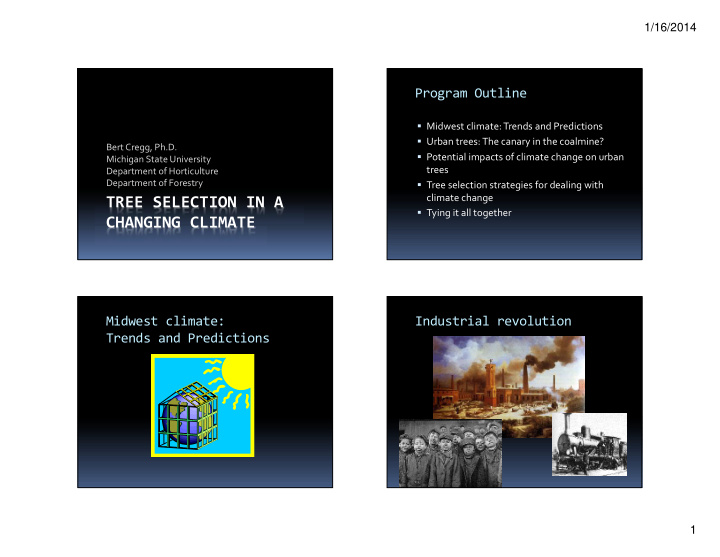



1/16/2014 Program Outline Midwest climate: Trends and Predictions Urban trees: The canary in the coalmine? Bert Cregg, Ph.D. Potential impacts of climate change on urban Michigan State University trees Department of Horticulture Department of Forestry Tree selection strategies for dealing with climate change TREE SELECTION IN A Tying it all together CHANGING CLIMATE Midwest climate: Industrial revolution Trends and Predictions 1
1/16/2014 Since the mid-1800’s CO2 concentration has increased from 280 ppm to ~395 ppm Predicted to reach 700 ppm by 2050 2
1/16/2014 Recent changes in Minnesota Climate warm winters, during which higher temperatures have been both persistent and substantial; higher minimum temperatures; increased episodes of high summer dew points; greater annual precipitation, most profoundly in seasonal snowfall and thunderstorm rainfall. Seeley, Mark W. Minnesota Weather Almanac Annual minimum Temp MSP 0 -5 -10 -15 -20 Zone 4b -25 -30 2000 2001 2002 2003 2004 2005 2006 2007 2008 2009 2010 2011 2012 2013 3
1/16/2014 Minimum temperatures are warming faster than average temperatures Krakauer, 2012 Urban trees: The canary in the coalmine? 4
1/16/2014 Atmospheric water Vapor pressure deficit: at 30% RH VPD doubles for each 20 o F (11 o C) increase in temperature 12 vapor pressure (kPa) 10 8 VP deficit 6 Actual VP 4 2 0 55/13 75/24 95/35 115/46 temperature (F/C) 5
1/16/2014 126 o F 50 downtown temperature ( o C) East campus 117 o F Lincoln WSO 40 108 o F 30 0 vapor pressure deficit (kPa) 12 10 8 6 4 2 0 12am 4am 8am 12pm 4pm 8pm 12am Cregg and Dix 2001. J. Arbor. 27:8-17 Cregg and Dix 2001. J. Arbor. 27:8-17 The great March warm-up of 2012 Respiration increases 2012 Daily high temperatures vs. 25-year average high exponentially with temperature 90 2012 80 25 yr avg 70 60 50 40 30 20 10 1-Jan 15-Jan 29-Jan 12-Feb 26-Feb 11-Mar 25-Mar 8-Apr 22-Apr Source: Bolstad et al. 1999. Tree Phys. 19:871-878. 6
1/16/2014 March 19, 2012 7
1/16/2014 What goes up… April 2012 Daily low temperatures 60 55 50 45 40 35 30 25 20 1-Apr 8-Apr 15-Apr 22-Apr 29-Apr 8
1/16/2014 Was 2012 an aberration or sign of things to come? Impacts of climate change on phenology Source: Badeck et al. 2004. New Phyologist. 162:295-309 Source: Gunderson et al. 2012 Global Change Biology 18:2008-2025. 9
1/16/2014 Source: Gunderson et al. 2012 Global Change Biology 18:2008-2025. Strategies for dealing with climate change 10
1/16/2014 Assisted colonization Organisms have three principle means to respond to a change in their environment Migration Adaptation Acclimation 11
1/16/2014 Provenance tests as surrogates BC Forest Service Assisted for climate change Migration Adaptation Trial Schmidtling 1994: Tree Phys. 14:805-817 Northern seed sources break bud early and Moving seed sources northward may be subject to late frosts often results in increased growth Schmidtling 1994: Tree Phys. 14:805-817 Johnsen et al. 1996. Tree Phys. 16:375-380 12
1/16/2014 MSU Shade Tree Acclimation Study Physiological acclimation MSU Shade Tree Acclimation Study Species vary in their ability to acclimate to increased growth temperature 13
1/16/2014 Out-planting this spring with Greening of Tying it all together Detroit Midwest climate is getting warmer – especially winter temperatures Trees in urban and community forests are already ‘living on the edge’ Changes in phenological patterns and drought stress are likely to be first impacts Tying it all together (cont.) Moving species and seed sources northward Diversity remains the most viable risk management tool 14
1/16/2014 Selecting a diversified portfolio Abundance of major tree genera in six Midwest cities: 1980 vs. 2005 30 25 1980 2005 abundance (%) 20 15 10 5 0 Acer Picea Thuja Fraxinus Quercus Pinus Prunus Juglans Cercis Morus Source: Wade 2010 Are we making progress? 15
1/16/2014 Espresso Kentucky coffeetree Pacific sunset maple Acer truncatum x A. platanoides Gymnocladus dioicus “Espresso-JFS” ‘Warrenred’ Photo: ‘Great trees for Kansas City’ FaceBook Page Photo: ‘Great trees for Kansas City’ FaceBook Page Scarlet oak State street maple Quercus coccinea Acer miyabei ‘Morton’ Photo: ‘Great trees for Kansas City’ FaceBook Page Photo: ‘Great trees for Kansas City’ FaceBook Page 16
1/16/2014 Crimson spire oak Bur oak Quercus robur x Q. alba ‘Crimschmidt’ Quercus macrocarpa Photo: ‘Great trees for Kansas City’ FaceBook Page Photo: ‘Great trees for Kansas City’ FaceBook Page Red oak Ginkgo Quercus rubra Ginkgo biloba Photo: ‘Great trees for Kansas City’ FaceBook Page Photo: ‘Great trees for Kansas City’ FaceBook Page 17
1/16/2014 Thanks for your attention! 18
Recommend
More recommend